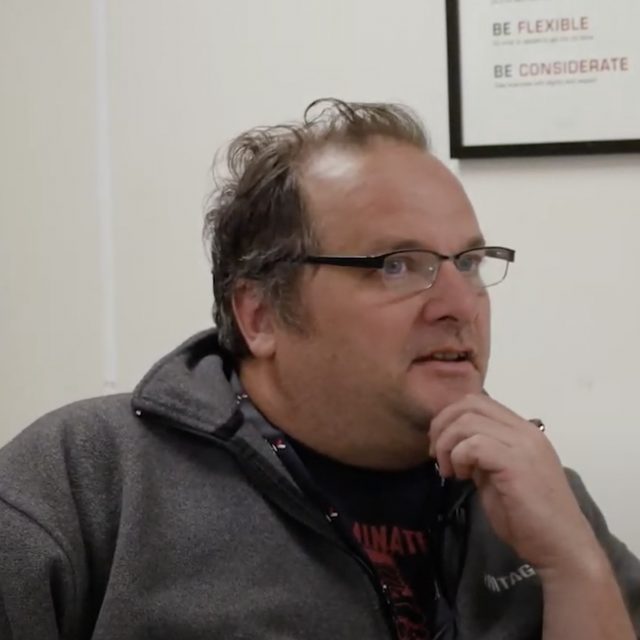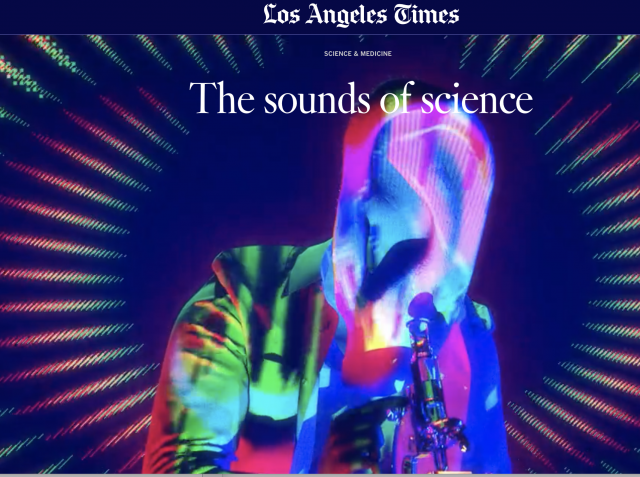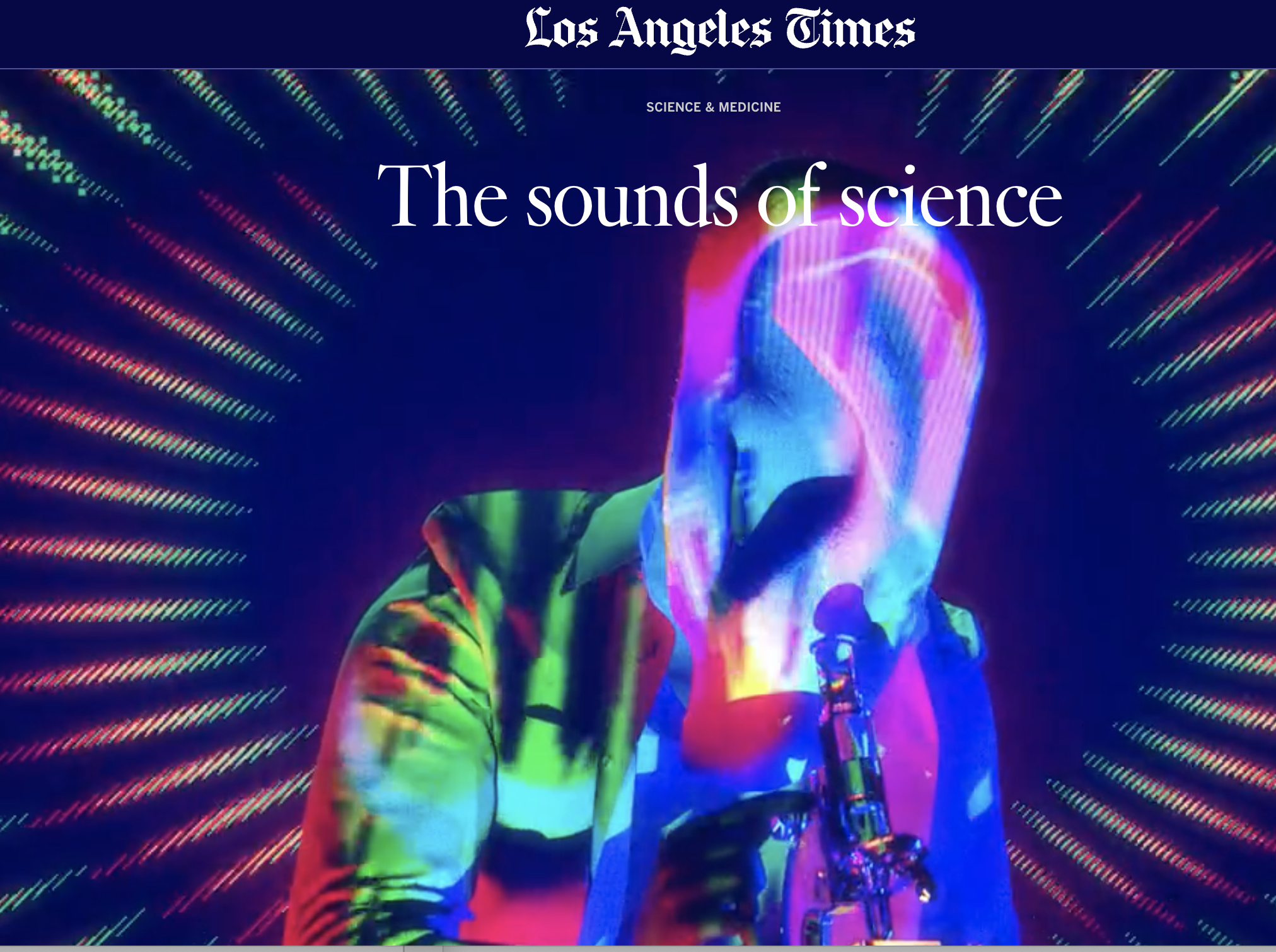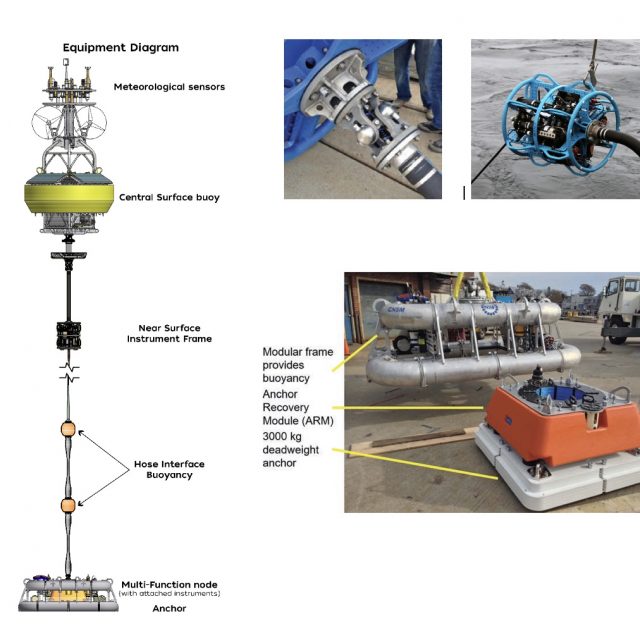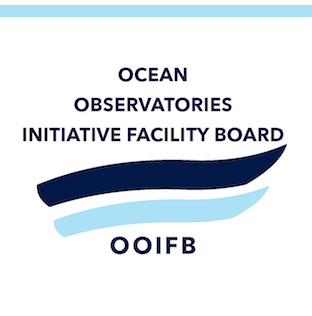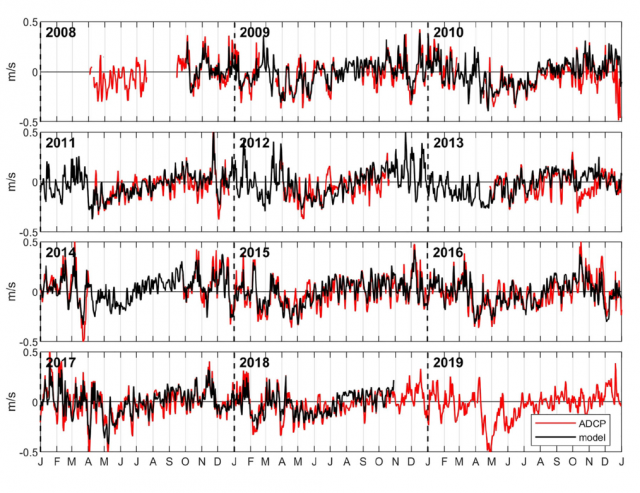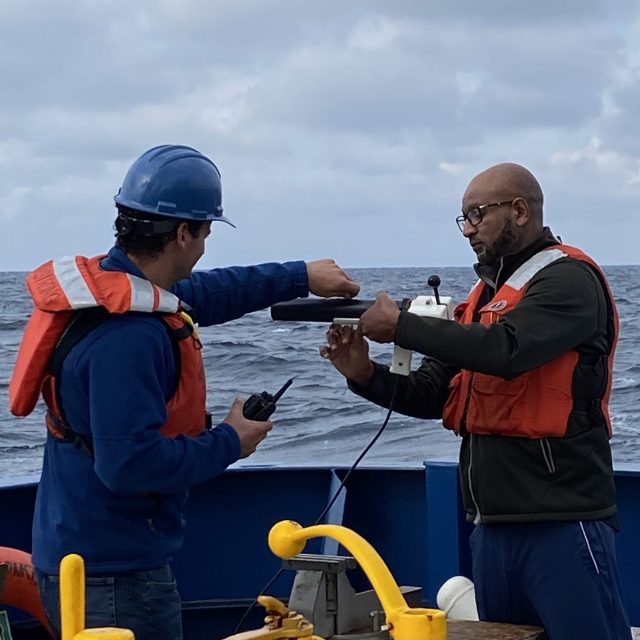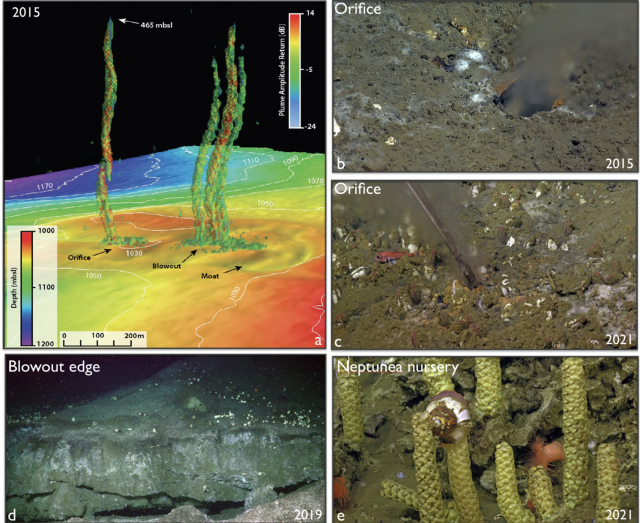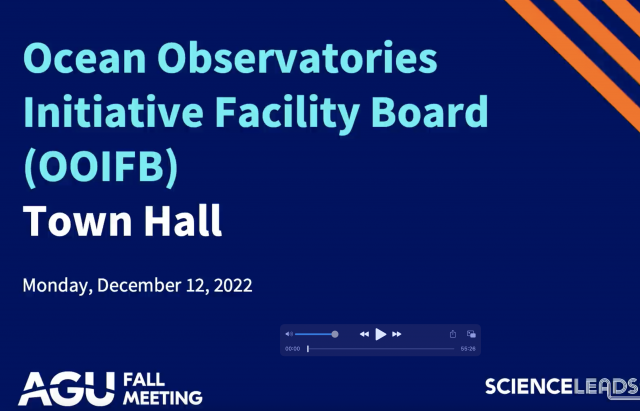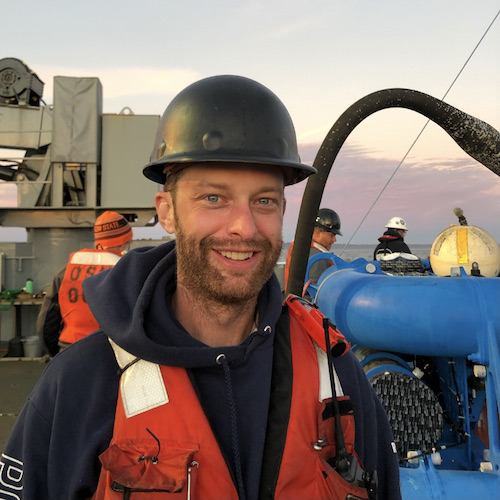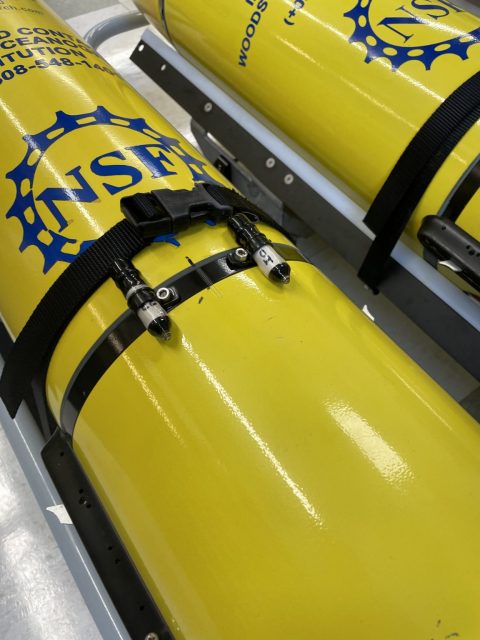Posts by ooistaff
Captain Eric Haroldson: 20 Years Aboard the Thompson
20+ Years on the Thompson; A Decade as Captain
Captain Eric Haroldson has lived half of his professional life as a captain aboard the R/V Thomas G. Thompson, which is operated by the School of Oceanography at the University of Washington. With a schedule of three months on, three months off, Haroldson spends roughly half his life at sea each year. And, when he returns to the vessel after three months on terra firma, he said, “The weirdest thing is that I can walk onto the ship after being away for three months and stand in the stair tower just after the galley. Same sounds same smells, everything’s the same. I click right back into it. It’s like I’ve never been gone.” Haroldson’s adjustment to land isn’t as smooth. He finds he needs to adjust to driving a car again and needs to have ceiling fans in his home to mimic the white and perpetual noise of the ship.
While onboard, Haroldson oversees offers 20 officers and crew, two marine technicians, and up to 36 scientists, depending upon the nature of the expedition. At home, he spends time making improvements to the home he built for himself in the woods.
In January, 2023, Haroldson marked a decade at the helm of the R/V Thompson. His journey started in the early 1980s, when he occasionally went to sea as part of the requirements for school and marine-related jobs. The seagoing bug finally hit him in full force in 1989, when he entered the California Maritime Academy. Four years later, he graduated with a third mates’ license and began a career focused on oil industry work.
His first job as a licensed officer was on an oil spill response vessel. After that, he sailed on oil tankers as a third mate. After the company he was working for was sold, he met some folks from Scripps Institution of Oceanography, which moved his career in the direction of oceanographic research. Haroldson sailed as third mate on a couple of Scripps’ ships, until the R/V Thompson needed someone to fill in for a couple of months in 1999. “That couple of months turned into 20 or something here, “ he joked.
Haroldson worked his way up to captain in a traditional way, starting as a third mate. After spending 365 days at sea, he was eligible to test to move up as a second mate. After another 365 days at sea, he tested for chief mate. With another 365 days at sea as chief mate and lots of additional classes and learning experiences, the next step was a master’s license, and ultimately followed by a captain’s license. Each step on the journey requires hands-on sea experience, as well as successfully learning (and passing) the requirements of the next job up the ladder with a host of new, different responsibilities.
Once Haroldson left the oil industry, he never looked back. “Not only is the work better aboard a research vessel, it’s more varied and interesting, not to mention important, but the variety is particularly important for those of us who have spent so much of their lives on the water.
He compared the work aboard an oil tanker – which ran between Valdez, Alaska and Exxon Benica in San Francisco Bay. “It was eight days to Valdez, a day and a half to load, followed by an eight-day journey to Benica, where we’d spend a day and a half offloading. The cycle constantly repeated itself and we could literally set our clock by it,” Haroldson explained. “When I started sailing oceanographic vessels, it was okay, well, this is more interesting, I was seeing something different every day. The variety of it gives the job definition and we manage the ship much differently.”
“As captain of a research vessel, we have the opportunity to work along-side scientists, which is great,” he added. “We sit around a table and together we figure out “how do we do this? Or how do we approach this? So there is not only the importance of the work that is happening onboard, but we have the opportunity to see the bigger picture of why this work is so important.”
[media-caption path="https://oceanobservatories.org/wp-content/uploads/2023/02/Screen-Shot-2023-02-10-at-3.05.25-PM.jpeg" link="#"]Captain Eric Haroldson looks out from the R/V Thompson’s bridge windows as Third Mate Todd Schwartz and AB Pam Blusk steer the ship thru the icy waters off Antarctica. Credit: Instagram.[/media-caption]While the ocean itself still presents the same challenges as it did 20 years ago when Haroldson began his journey, he has witnessed a lot of ancillary changes in how and where the ocean is used. “Ports are more interesting, with a greater variety of types of boats and people are fishing in areas where people didn’t fish ten years ago or so.” Haroldson added. He’s also witnessed the evolution of a more diverse crew, with women having a greater presence than in his early days aboard the oil tankers. At times, he’s sailed the R/V Thompson when all of the mates were female, and at other times, the crew has been more than half women.
Haroldson clearly relishes his job and provides a sense of safety, security, and humor while onboard. His greatest challenge seems to be always having to be two-steps ahead of everything in a realm where the rules and the physical condition under which he must safely operate his vessel are perpetually changing. This is no small task.
Sailing in and out of port at Newport Oregon is an example of staying two steps ahead of the game. Haroldson has to ensure that all ship operations are executed in a timely way so they can arrive at Newport at high tide slack water in daylight to avoid running aground. This requirement also provides the captain some flexibility in dictating scheduling. “If the weather is picking up and it will take a couple of hours to get to the site, there’s a decision to be made. Do you want to leave the dock and go out there and bounced around? Or does it make more sense to delay a little bit to the make the passage easier and more pleasant for everyone on board?”
Staffing creates another challenge onboard. Much like airline personnel, ship crew are limited in the number of hours they are allowed on the job. The maximum a crew member can work in a day is 15 hours. But if they work that full 15 hours, then for the next two days, they are only allowed to work up to a total of 20 hours. “We always have to be aware of the crew’s schedules and operate within these guidelines that help ensure safe operations.”
In looking back at his life on the water, Haroldson was enthusiastic about his path and optimistic of others who may follow him on a life well-lived a sea. “It makes for a challenging and rewarding life, and in some cases, there really are opportunities to travel and see the world. And, as long as one likes people and doesn’t mind being part of a community, it can be extremely gratifying—makes one appreciate life on and off the water.”
Read More
Accessible Ocean Reported in LA Times
On February 3, 2023, the Los Angeles Times reported on the work of Woods Hole Oceanographic Researcher Amy Bower and her colleagues on the Accessible Oceans Project. The team uses OOI and other auditory data to explore ways sound can be used to help visualize ocean science for the visually impaired. It’s cutting-edge, fascinating, and inclusive work.
Read the LA Times report on this important initiative.
Read MoreNew OOI Coastal Surface Mooring Design
The OOI Coastal Surface Moorings (CSMs) showcase a variety of innovative mooring technologies. Although the design concepts were initially developed as elements of other mooring systems, they were brought together for the first time on the OOI CSM. A recent paper by Peters et al. (2022) describes three areas where new design concepts were particularly impactful: (1) components at the interface between the surface buoy and mooring riser, (2) mooring riser components, and (3) an integrated seafloor anchor and instrument frame. These components work together to provide mechanical integrity for the mooring as well as mounting points for instrumentation and a reliable electrical pathway for the transmission of power from the surface to the seafloor and data from the seafloor to the buoy (Figure above).
Components comprising the buoy-to-riser interface include a universal joint, an electro-mechanical (EM) chain, and a Near Surface Instrument Frame (NSIF). The universal joint, at the buoy base, reduces the translation of buoy pitch and roll motion into bending moments at the top of the mooring riser. The EM chain, a conventional chain wrapped with helically-wound conductors and encapsulated in urethane, provides a flexible strength member between the buoy and the NSIF. The NSIF provides a mounting point for instruments and a mechanical transition from the EM chain to the EM cable.
Components along the mooring riser include the EM cable, EM stretch hoses, and distributed buoyancy elements between stretch hoses. The EM cable employs a wire rope strength member mechanically terminated with a swaged fitting. A molded urethane strain relief boot at the upper end of the cable interfaces with the NSIF bellmouth. The lower termination assembly provides strain relief and a cavity for integration of underwater connectors. The EM stretch hoses were initially developed in the 1990s by WHOI engineer Walter Paul. A novel, multi-layer construction technique was developed for OOI to enable a 24-conductor stretch hose. Hose lengths from 9 to 30 m are employed on OOI moorings. Each hose has a breaking strength of over 10,000 lb and stretches to over twice its original length to provide variable mooring scope and reduction of peak dynamic loads.
At the buoy base is an integrated anchor and instrument frame assembly called the Mult-Function Node (MFN). The MFN frame is a buoyant structure made of air-filled aluminum pipe, configured to allow the mounting of instruments, data loggers and batteries. The MFN is weighted to the seafloor with an anchor assembly that sits in the center of the frame, connected with dual acoustic releases. The anchor assembly consists of a flat-plate anchor below a foam buoyancy element that contains an internal spool with several hundred meters of synthetic line. The buoyancy element is connected to the anchor with dual acoustic releases. This system allows for mooring and anchor recovery in three stages: First, the MFN is separated from the anchor and the mooring riser is recovered. Next, the buoyancy element is released from the anchor allowing it to rise to the surface while offspooling line. Finally, the anchor is hauled using the synthetic line.
This unique combination of design elements creates a mooring system capable of housing and powering complex instrument systems, transmitting data in near real-time, and contributing to the long-term reliability of the OOI Coastal Surface Moorings in the challenging environment of the continental shelf.
Peters, D.B, J.N. Kemp and A.J. Plueddemann (2022). Coastal Surface Mooring Developments for the Ocean Observatories Initiative (OOI). Marine Technol. Soc. J., 56(6), 70-74. doi.org/10.4031/MTSJ.56.6.2.
Read MoreBio-Optics Sensor Summer School Applications Open
Are you interested in using OOI’s optical attenuation and absorption data in your research? Have you ever faced challenges finding and interpreting this type of data? If so, we hope you will consider applying for the 2023 OOI Bio-Optics Sensor Summer School.
The Ocean Observatories Initiative Facility Board (OOIFB) will host the summer school on July 17-21, 2023 on the campus of Oregon State University in Corvallis, OR. The course will focus on learning how to analyze and interpret the Sea-Bird AC-S measurements of optical attenuation and absorption. The AC-S is a hyperspectral instrument used to characterize the way seawater absorbs and scatters light and total scattering can be derived for living and detrital particles in the ocean. The OOI Program deploys the Sea-Bird AC-S on most of the OOI platforms, including coastal, cabled, and high latitude moorings.
Marine phytoplankton play an important role in ocean ecology and global biogeochemical cycles. The optical attenuation and absorption data from the AC-S provides information on the relative biomass of different phytoplankton size classes and phytoplankton functional types. In addition, other biogeochemical proxies, such as particulate organic carbon, may be estimated. The AC-S data also may be used to validate remote sensing measurements. These observations will be useful in addressing science questions covered by several OOI research themes including:
- Climate Variability, Ocean Circulation, and Ecosystems.
- Coastal Ocean Dynamics and Ecosystems.
- Turbulent Mixing and Biophysical Interactions.
About 25 advanced graduate students, post-doctoral fellows, and early career scientists will be selected as participants for the summer school. Other career level researchers will be considered, based on space availability. Participants should have a general understanding of oceanography/biology. Only applicants from U.S institutions can be considered. Participation will be in-person only and all selected students must be available to attend all days of the course. Funding for reimbursement of travel expenses, accommodations, and meals is offered.
Additional details about the summer school program, as well as a link to the application form are available here.
Please submit your application by the end of the day on February 28, 2023. Selections and notifications will be made in March.
Slope and Shelf Flow Anomalies Off Oregon
Slope and Shelf Flow Anomalies Off Oregon Influenced by the El Niño Remote Oceanic Mechanism in 2014–2016
Adapted and condensed by OOI from Kurapov et al., 2022, doi.org/10.1029/2022JC018604.
[media-caption path="/wp-content/uploads/2023/01/Endurance-science-highlight-fixed.png" link="#"]Time series of the daily averaged meridional current component at the Oregon shelf location, averaged in the vertical between 60 and 70 m below the surface: (red) ADCP data and (black) model. Data from before 2015 come from various moorings maintained at the NH-10 site. Data after 2015 come from the OOI Oregon shelf site. The model reproduces the observed variability over the entire 10-year period very well, except for episodes in Dec 2010 and Oct 2013. Overall, no systematic biases or trends are found. See Fig. 7 Kurapov et al. (2022).[/media-caption]Kurapov et al. analyze outputs of a regional ocean circulation model to demonstrate the measurable impact of the El Niño remote oceanic forcing mechanism along the US West Coast during the major heat wave period of 2014–2016. The 2-km horizontal resolution model, based on the Regional Ocean Modeling System (ROMS), was run for the period of 2009–2018. Though the model does not assimilate observations, it performs well by comparison with time series data (including OOI data, Figure above) explaining observed variability on temporal scales from several days to seasonal and interannual.
The El Niño-related oceanic anomalies provided by a global state estimate are introduced in the regional model at the southern boundary at 24N. These propagate alongshore with coastally trapped waves (CTWs) and influence the variability off Oregon (41°–46°N). In particular, CTWs are evident in the subsurface along-slope current, vs, and in the depth of the 26.5 kg m3 isopycnal surface over the slope, z26.5. In summer 2014 and 2015, vs anomalies are positive (northward) and z26.5 anomalies are negative (deeper) along the US West Coast. In addition to the CTW patterns, z26.5 anomalies also exhibit slow-moving features associated with undercurrent widening, separation, and subsurface eddy variability. Over the Oregon shelf, El Niño conditions contributed to the sharp weakening of the southward alongshore current throughout the water column in July 2014 and 2015, despite the near-average southward, upwelling-favorable winds.
Kurapov, A. L., Rudnick, D. L., Cervantes, B. T., & Risien, C. M. (2022). Slope and shelf flow anomalies off Oregon influenced by the El Niño remote oceanic mechanism in 2014–2016. J. Geophys. Res.: Oceans, 127, e2022JC018604. doi.org/10.1029/2022JC018604.
Read MoreOOI Data Classroom at Sea
Ocean Data Labs researcher Sage Lichtenwalner took his data capabilities to the waves, so to speak, as he shared how Ocean Observatories Initiative (OOI) data can be used in the classroom with researchers and teachers aboard the R/V Neil Armstrong in early January. The OOI is funded by the National Science Foundation to collect ocean observations from five scientifically important sites in both the Atlantic and Pacific and make the data available over the internet for research and education.
Lichtenwalner, a research programmer at Rutgers University, was asked to join the cruise as part of an effort to build partnerships and future opportunities between STEMSEAS (Science, Technology, Engineering and Math Student Experiences Aboard Ships) and several Historically Black Colleges and Universities (HBCUs). The cruise was designed to align with STEMSEAS’ objectives and be both immersive and experiential for 12 participants from ten institutions, including six HCBUs. The idea was for faculty to experience the cruise as students on other STEMSEAS expeditions do, and to take back what they learned from their onboard experiences to share with their students and classes. They traveled from Woods Hole, MA to Pensacola, Fla., from January 3-11, 2023.
Lichtenwalner provided participants with practical, hands-on ways to integrate OOI data into their courses. During the eight-day cruise, Lichtenwalner gave four presentations to the group, including a demonstration about how they can use the OOI Data Labs Manual in their classes. “The OOI Data Labs Manual is an easy, accessible way to use real ocean data to teach oceanographic concepts,” he said. “Educators have found that the real-time nature of OOI data inspires students, making them more engaged with the data because of their timeliness and relevance.”
Lichtenwalner’s presentations were part of a series of talks given by the STEMSEAS team and HBCU participants, which included hands-on activities and resources to build students’ problem-solving and scientific thinking skills. Participants also shared their research and teaching strategies to foster collaborative discussions.
[media-caption path="/wp-content/uploads/2023/01/group-shot.png" link="#"]Spending eight days at sea together provided participants with plenty of hands-on learning about sampling at sea, as well as opportunities to share research and teaching strategies they use when on land.[/media-caption]
Onboard the R/V Neil Armstrong, Dr. Magdalena Andres, a physical oceanographer at Woods Hole Oceanographic Institution and co-Principal Investigator of the PEACH program, which is investigating physical processes that drive exchanges between the shelf and deep ocean at Cape Hatteras, served as chief scientist on the cruise. She put the visiting team to work, helping deploy instruments and make underway measurements as part of the “SWOT Adopt a Crossover Field Campaign—Cape Hatteras.” The project, funded by NASA’s Jet Propulsion Laboratory, falls under the umbrella of the Surface Water Ocean Topography (SWOT) Adopt a Crossover Consortium. Andres is part of a multi-institution research team that has “adopted” the site east of Cape Hatteras near the OOI Mid-Atlantic Bite array site, both to advance the community’s dynamical understanding of this key oceanographic region and to help validate measurements provided by the SWOT satellite which launched in December 2022. “SWOT promises to revolutionize our understanding of earth’s surface water. It’s exciting to have the STEMSEAS, HBCU, and Ocean Data Labs participants working side-by-side with the project’s scientists, engineers, students, and technicians on this forefront of ocean observing,” explained Andres.
[media-caption path="/wp-content/uploads/2023/01/IMG_5670-2-scaled.jpeg" link="#"]Loretta Williams Gurnell (right), founder of the SUPERGirls SHINE Foundation, is learning about atmospheric turbulence with a hands-on demonstration led by Dr. Alex Gonzalez from the Physical Oceanography department at the Woods Hole Oceanographic Institution. Alex is part of the NSF-supported DIYnamics Team, https://diynamics.github.io/pages/about.html, which is working to provide access to affordable materials for geoscience teaching demonstrations.[/media-caption]
While onboard, Andres had the team assist her in deploying current and pressure sensing inverted echo sounders (CPIESs) and XBTs (expendable bathythermographs), as well as collecting measurements with the ship’s CTD (conductivity, temperature, depth) profiler. CTDs measure vertical profiles of conductivity (a proxy for salinity) and temperature. XBTs collect profiles of temperature. CPIESs measure bottom pressure and vertical acoustic travel time data (a proxy for temperature and salinity profiles) and near bottom current measurements (velocity of ocean water). The CPIESs were left in place to collect data over the next 18 months.
In 2024, the OOI Pioneer Array will move to the Mid-Atlantic, not far from where the cruise deployed the CPIES and collected CTD casts. To prepare participants for future potential educational applications of OOI CTDs and other instruments in the area, Lichtenwalner made quick plots of the data collected along the way. “Doing real-time plotting to support operations is actually how I got started in oceanography, so it’s been fun to re-live that experience, while also introducing a new group of professors and educators to the power of using ocean data in real-life and in the classroom.”
Read More
Pythias Oasis: The First-of-Its-Kind Seep in the Oceans
Adapted and condensed by OOI from Philip, et al., 2023, doi: 10.1126/sciadv.add6688.
[media-caption path="/wp-content/uploads/2023/01/Screen-Shot-2023-01-26-at-10.21.55-AM.png" link="#"] a) A multibeam sonar image of the methane bubble plumes at Pythias Oasis in 2015. b) Pythias orifice in 2015 showing the fluid-dominated, sediment-rich plume, as first visualized on the discovery dive by the ROV ROPOS. The main orifice has been continuously active since 2015. c) Pythias’ orifice in 2021 with increased biological communities and a small Fe-rich chimney. d) The edge of a large collapse-blowout zone – coring across this area in 2019 recovered substantial methane hydrate. e) A Neptunea snail nursery between the orifice site and the blowout zone.[/media-caption]Pythias Oasis is the first-of-its-kind seep in the oceans, providing a window into controls on megathrust events along the Cascadia Margin. Pythias Oasis, discovered during the 2015 Regional Cabled Array (RCA) Operations and Maintenance Cruise, utilizing the hull-mounted sonar on the R/V Thompson, is unlike any seep site yet described along active margins with unprecedented fluid chemistries (Figure above). It hosts an intense fluid-dominated venting system issuing low-salinity, hydrocarbon-bearing fluids carrying low concentrations of suspended particles from a discrete orifice that has been continuously active since 2015. Detailed sampling, as part of an NSF OCE-funded expedition in 2019 (OCE 16582901), and another dive in 2021 (added onto the RCA 2021 cruise) show that the fresh, warm fluids (four times background temperatures) are venting at the highest discharge rates yet measured within the Cascadia Subduction Zone (CSZ) and that the fluids are extremely enriched in boron lithium and iron.
Pythias Oasis provides a rare window into processes acting deep in the margin with fluid chemistries indicating that the fluids are sourced near the plate boundary in the Central CSZ at minimum temperatures of 150-250°C. The high discharge rates are thought to reflect draining of fluids along an over-pressurized reservoir associated with the subduction zone-perpendicular Alvin Canyon strike slip fault, suggesting that the faults regulate pore fluid pressure and megathrust slip behavior along the Central CSZ.
Results from this work are presented in Philip, B.T., E.A. Solomon, D.S. Kelley, A.M. Tréhu, T.L. Whorley, E. Roland, M. Tominaga, and R.W. Collier (2023) Fluid sources and overpressures within the central Cascadia Subduction Zone revealed by a warm, high-flux seafloor seep. Science Advances (9), doi: 10.1126/sciadv.add6688.
Read MoreAGU Lightning Talks
Here is an opportunity to hear some of the latest findings and research in the works based on OOI data. Researcher presented their findings in one-minute lightning talks at the AGU Fall Meeting December 12, 2022 during OOIFB’s Town Hall. The presenters are listed by topic and time that they appear on the video. For questions, please don’t hesitate to contact the researchers directly.
- 0:10: Cesar Savage – Woods Hole Oceanographic Institution (virtual)
- 2:16: Artash Nath – MonitorMyOcean.com (virtual)
- 4:00: Karen Bemis – Rutgers, The State University of New Jersey
- 5:45: Ettore Biondi – California Institute of Technology
- 7:46: Amy Bower – Woods Hole Oceanographic Institution
- 11:53: Marine Denolle – University of Washington
- 14:05: Jiaqi Fang – California Institution of Technology
- 15:45: Aleck Wang – Woods Hole Oceanographic Institution
Read More
Alex Wick: Conducting Sea-going Operations
OOI Coastal Endurance Array Deck Lead Alex Wick has been working on ships for more than a decade. He is a classic example of learning the ropes from the bottom up. After receiving a degree in marine biology from the University of Santa Cruz, he took some scuba diving lessons, but really didn’t know what he wanted to do.
Wick started his journey aboard ships in 2012 sorting tools for a marine technician onboard the R/V Point Sur, out of Moss Landing, California. When offered the job, he had no idea what he was getting into. He showed up in shorts, street shoes, with no personal protective gear (PPE) at all, and no at-sea experience.
But he learned quickly and advanced from sorting sockets to needle-gunning the deck, which involves removing all of the old paint with a needle gun before applying a new coat of paint. This activity was when Wick was given his first set of PPE – safety glasses, knee pads, hard hat, and gloves – which gave him a real understanding of their importance during five days of back-breaking work.
[media-caption path="/wp-content/uploads/2023/01/Alex.jpeg" link="#"]Alex Wick has been deck lead for Endurance Operations since 2018. Credit: Darlene Trew Crist ©WHOI.[/media-caption]
Wick started repainting the deck of the boat. The captain, at the time, recognized Wick’s work ethic and dedication and continued to expose him to shipboard duties. From one cruise as a deck hand, he advanced to an 84-day expedition to Antarctica. He jokes that at the time he didn’t even know how to use a ratchet strap, which is widely used to secure heavy equipment on ships and elsewhere.
“The captain told me to secure a small boat under the A-frame,” said Wick. “I had no idea how to do, but figured it out. With one day of oceanographic experience under my belt, I was off to Antarctica.” As it turned out, it was the best possible hands-on learning experience for Wick, which ultimately led to him spending about 500 days at sea and his role with the Endurance Array team today.
“There was nothing like driving a boat in Antarctica with a guy with a crossbow on the bow of the boat directing me around chasing Minke whales,” added Wick. “We would come up alongside one of them, shoot a crossbow bolt into its dorsal fin to retrieve a bio-sample. I thought it was the coolest thing ever.”
This Antarctica expedition provided Wick with the foundational knowledge he now uses aboard the R/V Thomas G. Thompson during bi-annual recovery and deployment expeditions for the Coastal Endurance Array. His time on the Point Sur taught him how to run winches, use the A and J frames, which support the lifting of heavy equipment in and out of the ocean, and most importantly, how to work on a ship in a safe manner.
After Antarctica, Wick spent six years as a deck hand and marine technician, where he developed an innate understanding of how all the pieces move on deck. Jonathan Fram, who often serves as chief scientist for the Endurance expeditions likens Wick to a symphony conductor. “He directs the operations while always having an eye on each member of the ‘orchestra’ and what they should be doing at certain times. This orchestration is critical to getting the heavy equipment we deal with on and off board without incident.”
Wick moved to Oregon State University when his wife was accepted into a PhD program there. He was hired on as a marine technician on the R/V Oceanus, where he sailed for up to 100 days a year. But, a man of many interests, Wick grew tired of being away from home for such long stretches. He missed his family, mountain bike, fishing, and other activities afforded by living in Oregon. He applied for the job as deck lead with the Endurance Array team and has been on the job since December 2018.
His first trip to the dock in Newport after a fall Endurance expedition, where he saw the massive amount of equipment moved on and off the ship and in and out of the water, provided Wick with his leadership philosophy.
“I think that the person running the deck should be basically completely hands off. That way, we are able to actually observe everything and see the bigger picture of what’s happening,” said Wick. “As we’re doing recoveries or deployments, I’m always thinking of the next pieces of the puzzle. I want the folks on the back deck and on the bridge to know what to expect, so everyone knows what’s ahead and can plan for what they’re going to be doing.”
From the seeds of his earliest experience aboard the R/V Point Sur, Wick is totally committed to overseeing a safe operation. “The deck lead is responsible for everyone’s safety and making sure we’re doing things appropriately,” he explained. “Sure unexpected things can happen, but back deck operations can and should be done safely. I feel a great responsibility for making sure that everybody comes back with all their digits and we all return to shore having successfully completed the job and return to our family and friends.”
Wick’s favorite part of the job is working with the team. He joked, “We are all part of the communal suffering. Doing the same thing together. We have a lot of big toys that we get to play with safely. And, it really is special at sea. It’s cool to see the whales breaching, the dolphins racing the ship, the bioluminescence, and skies filled with stars. No matter how crusty and jaded we might be, it takes a team to put these moorings in the water, and deep down, I think we all really enjoy doing this.”
Wick has served as deck lead for six Endurance expeditions and has overseen the movement, deployment and recovery of 270 tons of scientific equipment. Not a bad record for a kid who started out sorting tools.
[media-caption path="/wp-content/uploads/2023/01/Alex-2.jpeg" link="#"]Wick choreographs the recovery and deployment of the Endurance Array moorings. Credit: Darlene Trew Crist ©WHOI. [/media-caption]
Read More
Science Highlights
Researchers from around the globe are using OOI data to identify short-term changes and long-term trends in the changing global ocean.
The Science Highlights included in the report below were compiled from quarterly reports submitted by the Ocean Observatories Initiative to the National Science Foundation from 2020-2022. They represent only a fraction of the scientific findings that are based on OOI data. A complete list of peer-reviewed publications based on OOI data can be found here.
[embed]https://issuu.com/oceanobservatoriesinitiative/docs/ooi_science_highlights_autosaved_.pptx?fr=sNzM0ZjQ2ODUxNTQ[/embed]
Read More

